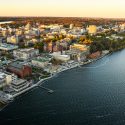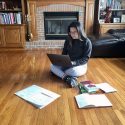Student survey results being used to improve fall, spring semesters
Campus leaders are using the results from two just-completed student surveys — one for undergraduates and one for graduate students — to improve the student experience during the remainder of the fall semester and to guide planning for the spring semester.
Both surveys sought to help university administrators better understand what has worked well and what has been challenging during a year upended by a global pandemic.
“This feedback will be immensely valuable in helping us maintain our commitment to student safety, health and success,” says Provost Karl Scholz. “COVID-19 has disrupted every aspect of society, forcing all of us into uncharted territory. It is crucial that we continue to listen to our students as we plan for the months ahead.”
The surveys were provided to all students Oct. 27, with responses due by Nov. 10 (undergraduates) and Nov. 16 (graduate students).
The undergraduate survey was a collaborative effort by the Provost’s Office, Student Affairs and the Division of Diversity, Equity and Educational Achievement. Its questions covered everything from academics and housing to food insecurity, campus resources and disability accommodations.
UNDERGRADUATE SURVEY HIGHLIGHTS
The undergraduate survey (click to download a summary) was completed by 5,328 students, a response rate of 17 percent. Among its academics-related findings:
- Nearly three-fourths of all undergraduate respondents indicated they hoped for at least some face-to-face instruction in the spring. When asked their preferences, they responded as follows: all courses in-person (22 percent); most in-person with some remote (19 percent); most remote with some in-person (19 percent); an equal number of both (15 percent); or all remote (26 percent). The university has announced plans to continue with a mix of in-person and remote courses in the spring.
- A majority of the respondents (55 percent) said either most or all of their courses were going well. The rest said about half were going well (19 percent); some were going well (20 percent); or none were going well (5 percent).
- For courses that respondents said were going well, 90 percent said the courses were well-organized all or most of the time, 87 percent said the instructors provided clear expectations all or most of the time, and 86 percent said their instructors communicated regularly all or most of the time.
- Respondents were almost equally split on which mode of remote learning has worked better for them. Fifty percent chose asynchronous sessions, which are recorded and can be viewed at any time, while 47 percent chose synchronous sessions, which are live. (The remaining 3 percent said they could not make a judgment because they hadn’t experienced both.)
- Eighty-four percent of first-year students who responded to the survey said they were “somewhat,” “very” or “extremely” confident about their overall success at UW–Madison.
“We’re of course happy that many of our students are having good academic experiences this fall, but there’s more work to do,” says John Zumbrunnen, who led the undergraduate survey effort and is vice provost for teaching and learning.
Zumbrunnen says survey results indicating that students are looking for more opportunities to engage with instructors and to connect with their peers fit with what he’s heard in focus groups with students this fall.
“We know that forming meaningful relationships with instructors and peers is crucial for student learning — and everything we’re hearing from students reinforces that,” he says. “While we can’t recreate the full on-campus experience, we can and will keep working to build engaging and interactive learning experiences for our students.”
Based on the survey and other student feedback, Vice Provost for Instructional Continuity and Academic Affairs Steve Cramer has announced a grant program to support faculty and departments in developing innovative ways to build engagement and interaction in spring-term courses.
“Purposely building opportunities for student interaction is new territory that can only partially replace the informal interactions and cooperative learning that students normally have on campus,” Cramer says. “We look forward to engaging the ingenuity of our instructors to address this need.”
GRADUATE SURVEY HIGHLIGHTS
As of Nov. 11, the Graduate School survey (click to download a summary) had been completed by 2,735 doctoral and master’s degree students, a response rate of about 30 percent. (Any additional responses received in the final days of the survey will be reflected in the final report in December.)
“Our survey looks at graduate students’ ability to make progress toward their academic, research, and scholarship goals amid the pandemic,” says William J. Karpus, dean of the Graduate School. “We also asked teaching assistants, who are integral to undergraduate education, what their experiences have been. The participation rate in the survey was very high, giving us some tremendously helpful data to inform decisions about where resources and support will be most beneficial.”
Among the findings of the graduate student survey:
- Respondents said the top three challenges they faced in making academic progress were the following: limited access to field experience (12 percent reported it as quite a bit of a challenge and 20 percent as a great deal of a challenge), limited in-person interaction with fellow students (32 percent reported it as quite a bit of challenge, nobody reported it as a great deal of challenge), and limited ability to collect face-to-face research data (12 percent reported it as quite a bit of a challenge and 18 percent as a great deal of challenge).
- When asked about financial difficulties due to COVID-19, difficulty paying rent/mortgage, or difficulty putting food on the table, fewer than 8 percent of graduate students said these were quite a bit or a great deal of a challenge.
- A majority of respondents reported no major challenges with access to required courses or course technology or with access to needed software, computing resources and storage.
- For graduate students teaching in-person, a majority reported no major issues with classroom facilities (42 percent reported not at all a challenge and 21 percent a little challenge), teaching spaces (46 percent and 13 percent reported not at all or a little challenge, respectively), and access to personal protection equipment (50 percent and 17 percent reported not at all or a little challenge, respectively).
“While we’re pleased that most graduate students teaching in-person did not report difficulties related to health and safety, we do take seriously any reports of challenges and will be following up to better understand and address those situations,” Karpus says.
In the weeks ahead, these initial results will be shared widely on campus so that administrators, faculty and staff can benefit from the feedback as they finalize plans for the spring semester. A full report, including qualitative analysis of the open-ended survey questions, is expected in December.
Tags: covid-19, provost, student affairs, student life



